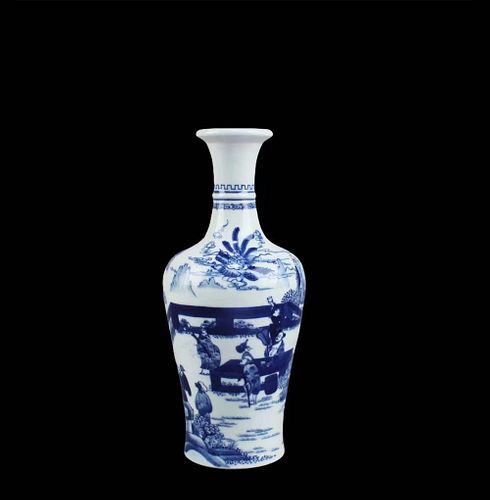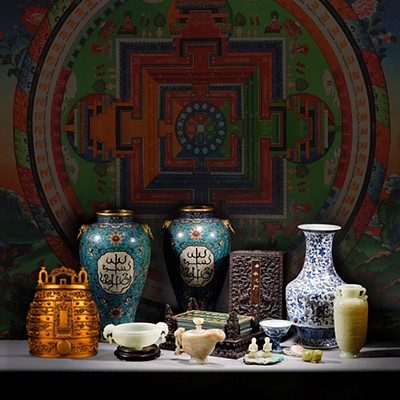Magnificent Guangxu imperial blue-&-white vase
About Seller
5091 Walnut Grove Ave
San Gabriel, CA 91776
United States
For over 30 years, Jumbo Auction House has been dedicated to curating collections of unique works of art for art lovers, decorators, novice collectors and fellow experts alike.
About Auction
Aug 10, 2022 - Aug 31, 2022
Jumbo Auction House is proud to bring you items of enticing Chinese works of art from private collection legacy, including important jade, bronze, cinnabar lacquer, paintings, jewelry, soapstone, snuff bottles, statues, porcelain vases, carvings, coins and much more! Jumbo Auction House jumboauction@yahoo.com
- Lot Description
This vase is not a common Guangxu marked ware; it has a very well potted body of fine and white clay. Its shape is elegant, with unusual details, e.g., the circular ridge around mid neck and a circular groove inside the mouth rim. The glaze is very uniform and unctuous. The underglaze cobalt blue, including the imperial mark, is brilliant pure blue unique to Guangxu period (1875 -1908 AD) and was used to paint the best imperial porcelain. The motif depicts celebration of the longevity of the Queen Mother of the West (Xi Wan Mu), a decorative theme popular during 19th century China. Xi Wan Mu is an ancient mythological deity and lives on a high mountain of the West. She came down to visit the kings and emperors when the world was at peace and prosperous. In this painting she sits on the back of a phoenix above of the mountains and clouds, while the Eight Immortals gather in a garden, each carrying his/her instrument, and raise their heads beaming at the Queen Mother. The garden is lavish with tall pines, strange rocks, and ground covering flowers. Even the crane that stands in the garden raises it head to worship the Queen mother. The Chinese antique market is full of imitations, especially of imperial porcelain of Qing Dynasty from Kangxi, Yongzheng, Qianlong, through Guangxu. Serious collectors must be careful in comparing and evaluating every detail to avoid buying fakes. Traditional experts and collectors of Chinese porcelain emphasize the quality of body (clay) , which is often described as jade-like, the glaze that must be even and unctuous, and the decoration that reflects the taste of the literati, by artistically arranging of the painting elements, not just piling on colored enamels to form dazzling displays of color. From Dr. Robert I-San Lin (#459), a senior Chinese artwork appraiser, whose grandfather was a major Chinese antique merchant in early 1900s. (Dr. Lin’s bio, in Journal of Authentication of Artworks, 2015, available). Brought to California in 1960s. H. 22.3 cm; 438 grams.NOTE: Any condition statement is given as a courtesy to a client, is only an opinion and should not be treated as a statement of fact. Jumbo Auction House shall have no responsibility for any error or omission. The absence of a condition statement does not imply that the lot is in perfect condition or completely free from wear and tear, imperfections, or the effects of aging. We do not carry out in-depth research of the sort carried out by professional historians and scholars, and any statements made by us orally or in writing about any lot concerning attribution to an artist, provenance, period, materials, origin, history, or dates represent an opinion of Jumbo Auction House and are not to be relied on as a statement of fact. Such opinions serve for informative purposes only and do not constitute historic or academic scholarship on the works and do not aim to substitute or contradict any such scholarship.
Condition
- Shipping Info
-
No property will be released until payment in full has cleared. Any expense related to packing, shipping and insurance (including reimbursement for damage or loss) of purchased lots is the responsibility of the buyer. Jumbo Auction House does not offer in-house shipping service for MOST items. Please arrange your own shipper to pick up the item(s) or we are happy to recommend shippers to you upon request. The emails of the two local shippers we recommend are on the invoice. Paid-for merchandise must be collected by the buyer or an authorized representative no later than forty-five (45) days following the date of the auction. Any merchandise remaining after this period will be subject to a storage fee of $10 per lot/per day. Please Note: Responsibility and all liability of items as well as safe delivery are assumed by carrier, shipper, buyer, agent or packing company upon acceptance of merchandise. Buyer will not hold Jumbo Auction House liable for any damage or loss after merchandise has been released from our possession.
-
- Payment & Auction Policies
-
Available payment options
-
-



 EUR
EUR CAD
CAD AUD
AUD GBP
GBP MXN
MXN HKD
HKD CNY
CNY MYR
MYR SEK
SEK SGD
SGD CHF
CHF THB
THB


























